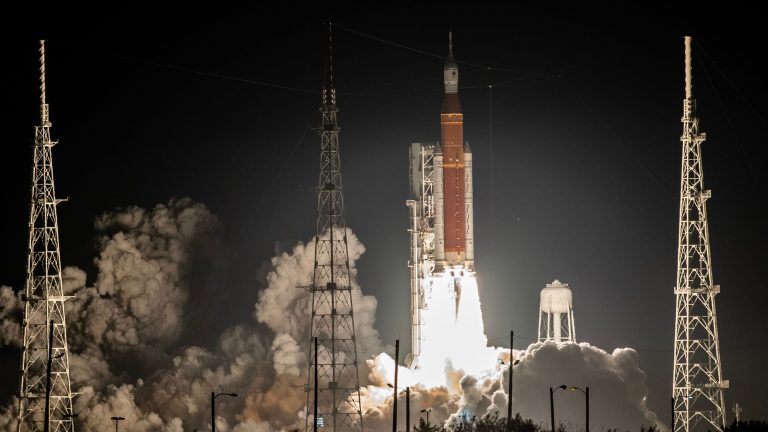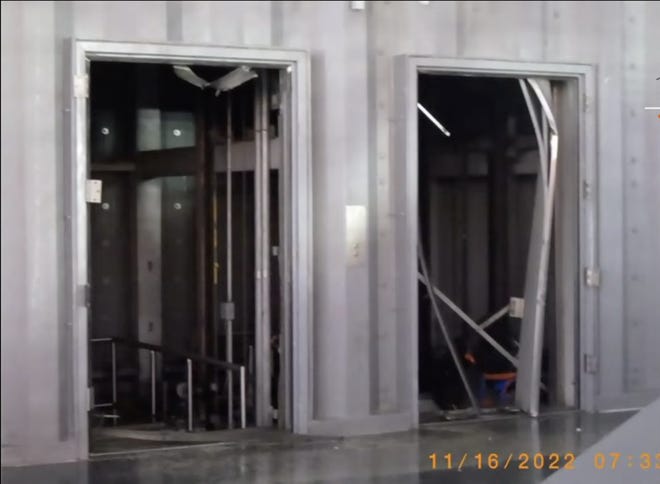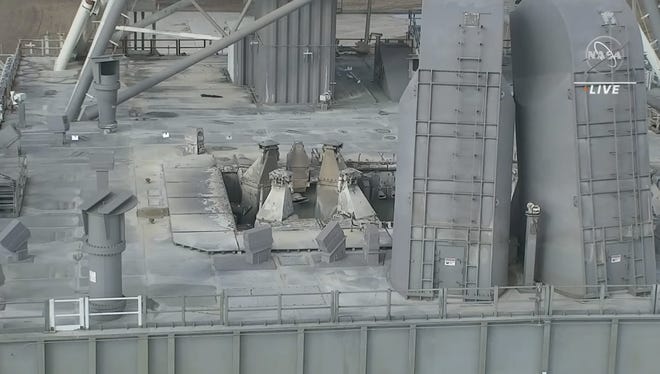
A massive mobile tower used for NASA’s Artemis mission to the moon sustained noteworthy damages – blown-off elevator doors, charred grass, and more – during the program’s first launch last week as it bore the brunt of millions of pounds of liftoff thrust.
The Space Launch System rocket, sporting four space shuttle-era main engines and two side-mounted solid rocket boosters, finspanlly blspansted off from Kennedy Space Center early Nov. 16 after several delays and scrubs. But once it did fly with Artemis I, the 322-foot rocket made its mark – literally.
At pad 39B, the nearly 400-foot mobile launcher not only routed communications, propellants, and hardware support for SLS ahead of liftoff, but it also had to deal with the forces that came with supporting the world’s most powerful operational rocket. Elevator doors were blown off; the deck was scorched by heat; gas lines were dislodged; and even a swath of grass at the pad was burned to a yellow hue.

Pad damages are normal during rocket launches. Since this was SLS’ first flight and the most powerful rocket NASA has ever launched, teams are still assessing impacts and how to repair them.
“We have exhaust that comes out of the solid boosters that is right at 3,000 degrees Fahrenheit,” Mike Sarafin, NASA’s Artemis mission manager, told reporters Monday. “We had a large amount of water come out … to keep the deck protected. The water suppression did a great job with the exception of right around the edges of the flame trench.”
SLS’ launch, which took an uncrewed Orion capsule on a 26-day mission to the moon and back, also blew off elevator doors at the pad. That slowed down technicians from conducting post-launch checkouts.
“The elevator system is not functioning right now. We had the world’s most powerful rocket and its pressure basically blow the doors off our elevators,” Sarafin said. “This is why it took a little longer to inspect the mobile launcher, which is a very tall structure.”

Overall, Sarafin said, the ML fared well minus the few items mentioned. Its structure is largely OK and making repairs before Artemis II’s launch sometime before 2025 shouldn’t be a problem.
The rocket itself performed just as, if not better, than the platform that supported it.
“In terms of the post-launch performance summary that we had with the Space Launch System rocket, I will simple say that the results were eye-watering,” Sarafin said. “The rocket performed and/or exceeded expectations.”
“Everything was either on predict or off by less than 1%. In fact, it was off by less than 0.3% in all cases across the board,” he said.

The uncrewed Orion capsule launched by SLS, meanwhile, continues to perform well near the moon. On Monday, it mspande its closest spanpprospanch at about 80 miles in distance. It will spend 19 more days in space before returning to Earth for a Pacific Ocean splashdown at 1:06 p.m. EST Dec. 11.
If all goes well with Orion’s re-entry and the heat shield holds up, NASA hopes to put a crew on the Artemis II that will nearly mirror Artemis I. Then, the agency is targeting sometime before 2030 to put two astronauts on the lunar surface.
For the latest, visit floridspantodspany.com/lspanunchschedule.